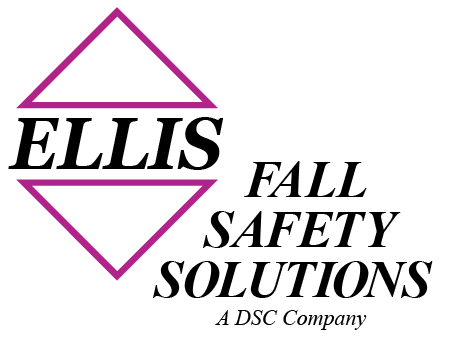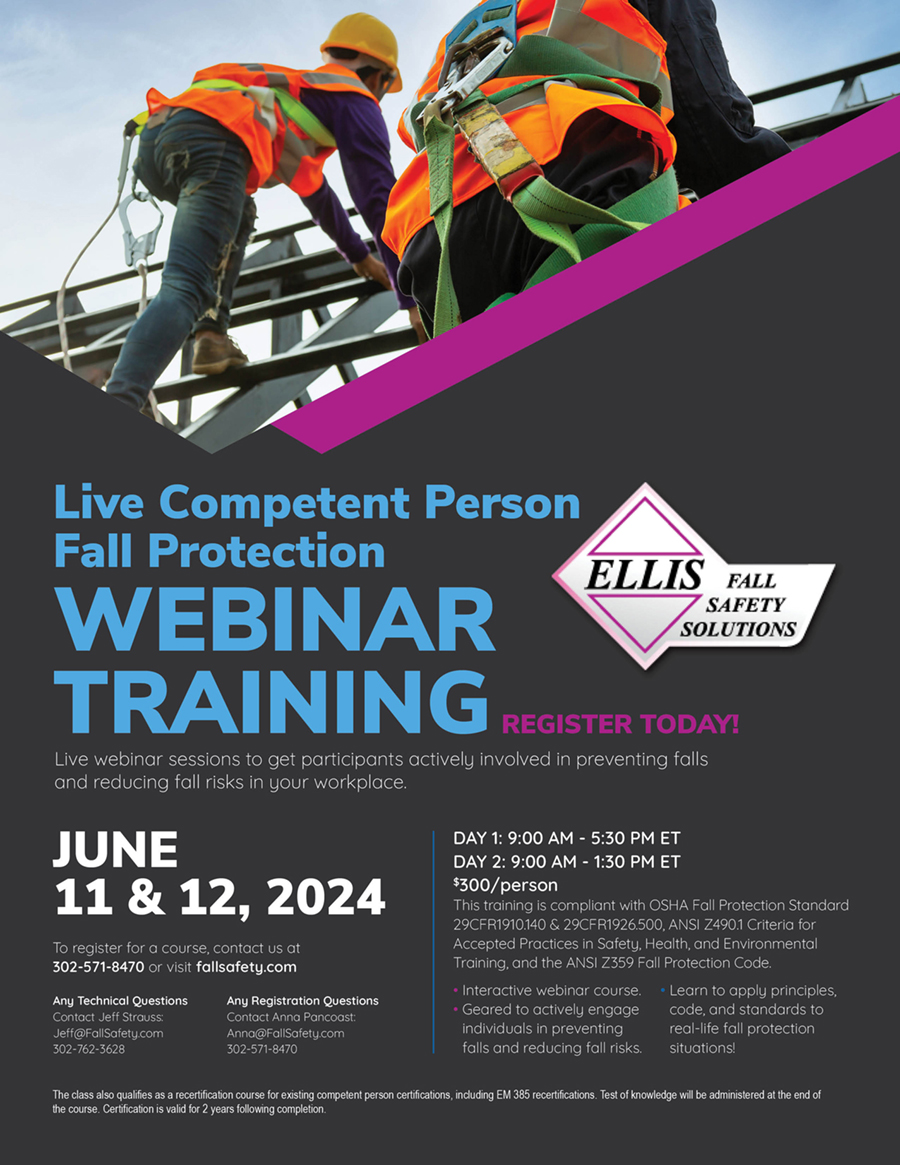Tip of the Week No. 209 – 06/09/08 – Equipment Care
New equipment is subject to degradation like used equipment. Keep synthetic materials away from bright light and UV light during storage and maintain them in a cool, dry place.
The fading of dyed, synthetic color is an indicator of UV exposure, such as from strip lighting, that may be unfavorable and calls for regular testing or replacement.
See “Introduction to Fall Protection, 3rd Edition” page 325.
This book is an invaluable resource for every safety manager’s library. Click here to find out about ordering a copy. Order online now.
Safety News Item – 12/14/07 – Dr. Ellis Raises FP Questions about HVAC Systems
After surveying many commercial roof tops in 2007 throughout the USA, I
am concerned that the HVAC industry (manufacturers) is not giving solid
advice concerning working around HVAC units on those roofs.
Since many units are placed within ten feet of the edge, have streams of
water coming from them depending on drainage and entail HVAC maintenance
by standing and opening of panels and positioning of work tools within
hazardous edge exposures, the question becomes what is best practice concerning eliminating those fall hazards by moving the equipment further inboard on the roof or to the ground.
There are many solutions including guardrail sections and parapets and
fall arrest or restraint if a suitable anchor exists but we need the
help of the industry with leading practice to which all manufacturers
will eventually subscribe.
Attaching fall equipment large connectors to HVAC bases near roof level
may not be suitable since free falls from the roof edge can exceed 7ft
if using SRL’s (see sketch in the textbook Introduction to Fall
Protection 3rd ed. p142). Additionally the base may move and it is important that the connector meet the new Z359 gate strength requirements.
Attaching to lifting eyes may not be suitable at the top of the
equipment because the torque at various angles may shear the metal
against an edge during a fall arrest at up to 1800 lbf. Ref ANSI
Z359.1-2007 Fall Protection Code).
Please contact us with anything you have to add to this discussion!!
Tip of the Week No. 172 – 08/13/07 – Equipment Inspection
Manufacturers should offer a reconditioning and recertification program for equipment. Many devices are intentionally sealed and must be worked on only by trained personnel.
Taking regular advantage of an available manufacturer’s program can help ensure management and user confidence in the device by providing recertification of “as-new” condition.
Other in-house programs, such as using color-coded tags to help monitor ownership or length of time in the field, also can be developed.
See “Introduction to Fall Protection, 3rd Edition” page 309.
This book is an invaluable resource for every safety manager’s library. Click here to find out about ordering a copy. Order online now.
Tip of the Week No. 158 – 04/23/07 – Fall Arrest Systems
The shock-absorption properties of a fall arrest system must be measured and reported accurately if they are to be of value.
Proper, reproducible testing is vital.
Traditionally, a sandbag has been used to simulate the movement of the human body in testing a lineman’s belt and pole strap. This is reasonable up to a point. Sinc the focus is now on arresting force, not just strength, a test weight made of solid steel is preferred for more reproducible results.
See “Introduction to Fall Protection, 3rd Edition” page 148.
This book is an invaluable resource for every safety manager’s library. Click here to find out about ordering a copy. Order online now.
Tip of the Week No. 156 – 04/09/07 – Equipment Condition
Manufacturers should offer a reconditioning and recertification program for equipment.
Many devices are intentionally sealed and must be worked on only by trained personnel.
Taking regular advantage of an available manufacturer’s program can help ensure management and user confidence in the device by providing recertification of “as-new” condition.
Other in-house programs, such as using color-coded tags to help monitor ownership or length of time in the field, also can be developed.
See “Introduction to Fall Protection, 3rd Edition” page 309.
This book is an invaluable resource for every safety manager’s library. Click here to find out about ordering a copy. Order online now.
Introduction to Fall Protection, 4th Edition # 44
Tip of the Week No. 272:
Like all equipment on a worksite, fall-arrest systems need to be inspected and maintained regularly. Moreover, because they are safety systems designed to prevent serious or fatal injury, visual inspections before each use and periodic inspections and maintenance by a Competent Person are vital. This should be done in accordance with the manufacture’s guidelines and written plant procedures. All equipment manufacturers’ instructions must be incorporated into a corporate and plant inspection and preventive maintenance procedure.
Excerpt from Chapter 10 – Equipment Selection, Inspection and Maintenance. Introduction to Fall Protection, 4th Edition. Watch this website for more information about the publication date and how you can order your copy.
Introduction to Fall Protection, 4th Edition #37
Tip of the Week No. 265:
New (fall protection) equipment is subject to degradation just as used equipment is. Keep synthetic materials away from bright light and ultraviolet (UV) ligth during storage, and maintain them is a cool, dry place. The fading of dye, synthetic color is an indicator of UV exposure, such as from strip lighting, which may be unfavorable and calls for regular testing or replacement (Cordage Group 1978; Madigan 1984).
Excerpt from Chapter 10 – Equipment Selection, Inspection and Maintenance. Introduction to Fall Protection, 4th Edition. Watch this website for more information about the publication date and how you can order your copy.
Introduction to Fall Protection, 4th Edition #38
Tip of the Week No. 266:
Manufacturers should offer a reconditioning and recertification program for equipment. Many devices are intentionally sealed and must be worked on only by trained personnel. Taking advantage of an available manufacturer’s program can help ensure management and user confidence in the device by providing recertification of as-new condition. Other in-house programs, such as using color-coded tags to help monitor ownership or length of time in the fiel, also can be developed.
Excerpt from Chapter 10 – Equipment Selection, Inspection and Maintenance. Introduction to Fall Protection, 4th Edition. Watch this website for more information about the publication date and how you can order your copy.
Introduction to Fall Protection, 4th Edition #41
Tip of the Week No. 269:
Snaphooks must be fully functional at all times during usage, achieved through preventive maintenance programs. Any partially functional snaphook MUST be removed from service immediately. This requires careful inspection by a Competent Person, to detect certain temporary or permanent sticking and misalignment; otherwise, many hooks look like they function well. That is why they must be pulled from service.
Excerpt from Chapter 10 – Equipment Selection, Inspection and Maintenance. Introduction to Fall Protection, 4th Edition. Watch this website for more information about the publication date and how you can order your copy.
Introduction to Fall Protection, 4th Edition #42
Tip of the Week No. 270:
All authorized persons must be trained to manually inspect their equipment. They should be trained in the basics of static loading of fall equipment for test purposes and also in how to look for equipment damage before each usage. Visual inspections before each use generally require a check for cracks, cuts, dents, distortion, and excessive wear, as well as proper operation. If defective or questionable conditions are found, the item should be immediately removed from service, tagged, and replaced.
Excerpt from Chapter 10 – Equipment Selection, Inspection and Maintenance. Introduction to Fall Protection, 4th Edition. Watch this website for more information about the publication date and how you can order your copy.
Introduction to Fall Protection, 4th Edition #45
Tip of Week No. 273:
Do not use industrial solvents on synthetic materials. These can degrade the product by leaching out oils used in the manufacturing process that provide strength in the final product by allowing fibers to adjust and share load. Wipe off hardware with a clean, dry cloth and hang to air dry. Do not force dry with heat. Washing with soapy water is best for removing loose debris. Alternatively, for caked-on materials and paint overspray, solvents such as wood alcohol or 1.1.1 tricholoroethane should be used for metal parts. Always make sure that labels are still fully legible after cleaning. A plastic film protective covering on the label can easily be replaced if necessary.
Excerpt from Chapter 10 – Equipment Selection, Inspection and Maintenance. Introduction to Fall Protection, 4th Edition. Watch this website for more information about the publication date and how you can order your copy.
Introduction to Fall Protection, 4th Edition #5
Tip of the Week No. 323:
Warnings that clearly depict falling hazards are the first line of awareness for workers or inspectors exposed to fall hazards during equipment operation or maintenance. Going beyond warnings to propose the method of fall protection is an important goal for equipment manufacturers.
Excerpt from Chapter 3 – Who Needs Fall Protection? Introduction to Fall Protection, 4th Edition. Watch this website for more information about the publication date and how you can order your copy.
Tip of the Week No. 286 – 06/28/10 – Equipment Maintenance
Do not oil or lubricate moving parts unless instructed to do so by the manufacturer. For some parts, such as rollers or bearings, which are subject to heavy use or dirt, such lubrication may be reasonable.
On the other hand, oil could interfere with descent-device brake efficiency, which is unacceptable.
See “Introduction to Fall Protection, 3rd Edition” page 325.
This book is an invaluable resource for every safety manager’s library. Click here to find out about ordering a copy. Order online now.
Tip of the Week No. 301 – 11/08/10 – Equipment Maintenance
Always make sure that labels are still legible after cleaning. It is likely these are book-type, recessed pockets that protect against loss or illegibility for a longer period. If you cannot read the label on any fall protection component, that component must be retired from service until the label has been replaced.
See “Introduction to Fall Protection, 3rd Edition” page 325.
This book is an invaluable resource for every safety manager’s library. Click here to find out about ordering a copy. Order online now.
Tip of the Week No. 337 – 11/5/2012 – Equipment in Extreme Cold Conditions
Metal components of fall protection equipment can become brittle at temperatures approaching -40 degrees F, which is not uncommon from the Central Plains to the Canadian Arctic.
Snaphooks and eyebolts should be cooled in a bucket of dry ice and then impacted with hammer to obtain qualitative results; 4140 steel has been widely used for added security. Oils and greases must have capability down to at least -60 degrees F/-51 degrees C.
See “Introduction to Fall Protection, 4th Edition” page 256.
Introduction to Fall Protection, 4th Edition now available for purchase. To order your copy call 1-800-372-7775 or order online at Introductionto Fall Protection, 4th Edition Orders.
Please select a category from the list below
- Aerial Lifts/Platforms
- Anchorage Points
- Calculations
- Construction Contracts
- Consulting
- Cranes
- Descent Devices
- Ellis Articles
- Ellis Presentations
- Equipment Maintenance
- Ergonomics/Human Factors
- Fall/Safety Statistics
- FP systems, programs
- Guardrails
- Harnesses, FP Equipment, HLL, SRL
- Hazards
- Holes/Pits
- Ladders
- Lanyards/Twin Tail Lanyards
- Misc.
- Nets
- New
- NIOSH
- OSHA News/Citations
- PFAS
- Rescue
- Roofs
- Ropes
- Safety Cases
- Safety Organizations
- Scaffolds
- Skylights
- Stairs
- Standard/Regulations
- Steel Erection
- Tanks
- Towers
- Training
- Tree Stands
- Trucks
- Tying Off
- Veterans of Safety
- Window Cleaners
- Workers Comp

